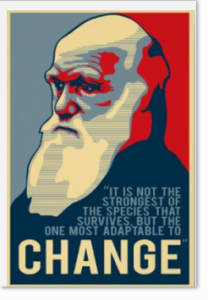Peter Drucker once was quoted: Within five years, if you’re in the same business you are in now, you’re going to be out of business. Your success with building a change and adaptability culture in your business depends not only on coming up with great ideas and making them happen but also with establishing motivators for creating adaptability.

No business attribute is more important today as that of adaptability, as many, many businesses are on the brink of irrelevance … unless they change as fast as change itself. You need to have and try many creative business ideas as often as possible … take to heart what Peter Drucker had to say in the quote shown above.
A crucial point to remember is that you can’t dictate change by mandate. You can’t overpower, but must attract people and empower them so that they can take ownership of the cause and make it their own. You need to accept that people will do things for their own reasons, not for yours.
Most of all, remember that every action has to have a clear purpose and be directed at influencing specific institutions. So before taking any action, ask two questions: Who are we mobilizing, and to influence what?
That is why this needs to be a part of the culture of your business.
Check out our thoughts on building innovation.
It’s also important to recognize that culture comes from the people—it is the people. Think about the individuals within your organization—what are their personalities like?
Who are they outside of work? What tickles their fancy? All of these things lend to the culture of your organization, and ultimately your products
We live in a business world accelerating at a dizzying speed and teeming with ruthless competition. As most of the tangible advantages of the past have become commoditized, creativity has become the currency of success.
A 2010 study of 1,500 CEOs indicated that leaders rank creativity as the No. 1 leadership attribute needed for prosperity. It’s the one thing that can’t be outsourced; the one thing that’s the lifeblood of sustainable competitive advantage.
Unfortunately, most companies fail to unleash their most valuable resources: human creativity, imagination, and original thinking. They lack a systematic approach to building a culture of innovation and then wonder why they keep getting beaten to the punch.
Creative change and adaptability could become the main strengths of your company and the pillars of its long-term growth and success.
Here are some useful tips on how to help move toward a change and adaptability culture in your business:

Encourage curious, imaginative minds
We are big believers in change and adaptation. They contribute heavily to creative minds. We’re first curious about something, and it’s that curiosity that drives us to create new ideas.
Try to think of inventors who created something without first being curious or imaginative. Difficult isn’t it?
Create a spirit of collaboration
Your employees should feel like members of one big family. They are the biggest assets of your business.
Creativity doesn’t often happen in a vacuum. As the author Steve Johnson says, chance favors the connected minds. When people are together, talking, laughing, thinking, exploring — they’re going to throw out ideas.
These ideas trigger something in someone else’s mind, and it snowballs. Before long, this group of folks has developed a creative change that wouldn’t have been possible without the collective collaboration.
Don’t fall prey to the myth that only some people are adaptable and you’re not one of the chosen few. We are all adaptable; it’s just a matter of figuring out in what way.
So find things you’re curious about and that are interesting to you, use your imagination a little, stay motivated and work at it, and surround yourself with others who are doing the same.


